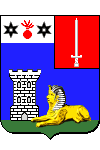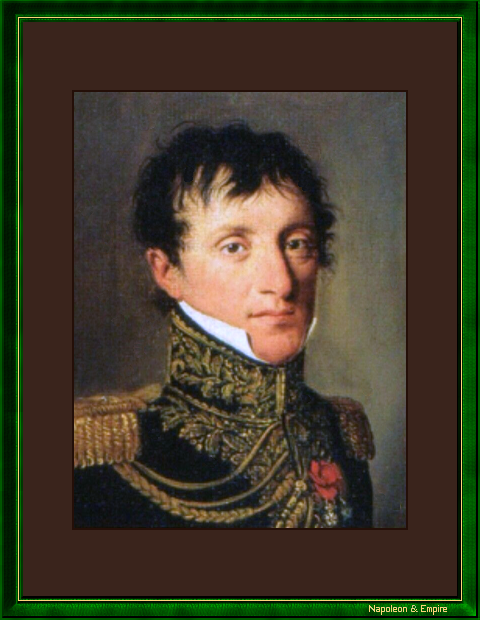Amédée (Amé) Pierre Chastel - Major General
Baron of the Empire
Pronunciation:

Amédée (known as Amé) Pierre Chastel was born in Veigy, in the Duchy of Savoy [now Veigy-Foncenex in Haute-Savoie], on April 29, 1774. His father, Nicolas Chastel, was a landowner, a liberal, and a Freemason, holding the essential position of notary-secretary in the village's municipal administration. His mother, Marie Favrat, connected him to the bourgeoisie and minor nobility of the Chablais region.
Following in the footsteps of his four older brothers, Pierre-Aimé (the names by which he is remembered) studied at the college in Thonon, run by monks of the Barnabite order, where his uncle Michel was one of the administrators. He proved to be a serious and diligent student. Like them, he enthusiastically embraced the French Revolution and enlisted in August 1792 in the Allobroges Legion, where he was assigned to a dragoon company.
An excellent horseman, he rose through the ranks rapidly. A private when he enlisted, he was a corporal on November 2, 1792, a sergeant on the 12th of the same month, a second lieutenant on December 6, and a lieutenant on the 9th!
With his unit, he first served in the Army of the Alps and then in the army before Toulon, organized to besiege the city at the end of 1793. In January 1794, he was promoted to captain upon his transfer to an elite dragoon regiment, which he joined in February. He spent the next two years with the Army of the Eastern Pyrenees before being placed on reserve for a few months between March and July 1796.
He returned to active duty with the Army of Italy, with which he participated in the entire campaign until the crossing of the Tagliamento River on March 16, 1797. On that day, he was seriously wounded in the head by three saber blows. His convalescence was lengthy. In December 1797, his regiment was transferred to the Army of Helvetia, then to the Army of Egypt in May 1798. Beginning in August, he accompanied general Louis Charles Antoine Desaix's expedition to Upper Egypt, which reached the First Cataract of the Nile. It was during this journey that he discovered, perhaps in the company of Desaix and Augustin Daniel Belliard, the famous Dendera Zodiac, an ancient Egyptian bas-relief depicting the sky and constellations. Transported to France in 1821, this sculpture has since become one of the masterpieces of the Department of Egyptian Antiquities at the Louvre Museum. Chastel returned to France in November 1801 aboard the Experiment, a British ship participating in the repatriation of the French expeditionary force, in accordance with the terms of its surrender.
On January 2, 1802, Chastel was promoted to squadron leader, then to major on October 29, 1803. On March 26, 1804, he was awarded the insignia of Knight of the Legion of Honor.
He returned to combat in 1805 during the campaign in Germany. During the battle of Austerlitz, Chastel once again demonstrated his courage. His reward came fifteen days later in the form of an appointment as second major of the Horse Grenadiers of the Imperial Guard, the elite of the Grande Armée. In its ranks, he served during the Prussian and then Poland campaigns, participating in the famous monumental charge at Preußisch Eylau. A week after this battle, which significantly thinned the ranks, he was promoted to colonel.
In March 1808, he received the title of Baron of the Empire shortly before departing for Spain, where he distinguished himself in another cavalry charge: the battle of Burgos (November 10, 1808). This earned him the rank of Officer of the Legion of Honor (November 16).
The Guard then accompanied the Emperor to Austria, where the war resumed at the initiative of the Fifth Coalition. Chastel fought at Aspern-Essling (May 1809) and then at Wagram (July). At the end of the hostilities, he became Colonel-Major of the Horse Grenadiers of the Imperial Guard.
After serving in France for a year and a half, Chastel returned to the battlefields in Spain. There, he earned his brigadier general's stars (August 7, 1811).
As part of the preparations for the French invasion of Russia, Chastel left the Imperial Guard to take command of a division, with the corresponding rank, in General Emmanuel de Grouchy's Cavalry Corps (April 1812). During the campaign, his unit participated in all the major engagements, and in particular in the assaults on the Great Redoubt during the battle of Borodino (Moskova).
The following year, he transferred to the corps of General Marie-Victor-Nicolas de Fay de La Tour-Maubourg. He fought at Lützen, Bautzen, Kulm, and Leipzig. Shortly before this, the Legion of Honour commander's tie was awarded to reward his conduct during the first months of the campaign in Saxony.
In 1814, Chastel played only a limited role in operations, awaiting a command which he finally received on March 18, 1814, as senior commander of all cavalry between Meaux and Paris. In this position, he attempted to defend the capital during the battle of Paris (March 30, 1814). In the following days, Auguste Viesse de Marmont, aware of the Savoyard general's devotion to the Emperor, kept Chastel out of the negotiations that preceded the Marshal's defection.
After Napoleon's abdication, Chastel rallied to Louis XVIII, applied for and received the Cross of Saint Louis, but was simultaneously placed on inactive duty.
He returned to service on March 31, 1815, once again commanding a cavalry division. As part of Grouchy's corps, Chastel fought on June 18th at Wavre, not at Waterloo as is often mistakenly stated.
Discharged along with the rest of the Hundred Days army on October 22, 1815, Chastel once again found himself inactive.
Born a subject of the King of Sardinia in a town that ceased to belong to France by the Treaty of Paris of 1814, Chastel was no longer considered French and was forced to apply for citizenship in the country he had served for over twenty years. He was kept waiting for three years, especially since he continued to display a Bonapartism that was now of dubious character. He initially settled in the Ain region, near his birthplace, but was eventually forced to move to the south of France, placed under house arrest like the other "foreign" officers. He spent a year there before finally receiving his naturalization papers in August 1817. He declared himself domiciled in Ferney-Voltaire, but usually resided in Geneva, where he was the center of a circle of former military men nostalgic for the Emperor.
He retired in February 1825 and died on October 16, 1826, in Ferney-Voltaire, probably from acute peritonitis. He was buried in the Plainpalais cemetery, where his grave no longer exists.
"Pierre-Aimé Chastel". French scholl of 19th century

Acknowledgments
We would like to sincerely thank Mrs. Laurence Pillonel, deputy mayor of Veigy-Foncenex in charge of culture, who clarified the pronunciation of General Chastel's name for us.